- NLI Research Institute >
- Toward the Practical Use of Credit Ratings in Japan's Financial Markets
Toward the Practical Use of Credit Ratings in Japan's Financial Markets
Takahiro Niimi
Font size
- S
- M
- L
1. Introduction
A recent phenomenon has emerged among investors who, dissatisfied with corporate disclosure of internal information, are relying more on credit ratings as an external source of information. As the use of credit ratings become widespread, in this report we look at their importance to financial markets, limitations for proper use, and extent of usage in Japanese markets.
2. Definitions and History
Credit ratings express a credit rating agency's evaluation of credit risk−the risk that an issuer of a bond may be unable to make timely principal and interest payments. In other words, ratings express the default risk of bonds,1and not the issuer's growth potential, competitiveness, or business failure risk. Bonds issued by the same issuer can and do receive different credit ratings depending on collateral and other conditions. Above all, credit ratings are not objective data like economic statistics, but subjective evaluations made by credit rating agencies.
Typically, credit ratings are issued on long-term bonds and CP (commercial paper). In addition, there are long-term deposit ratings, bank finance strength ratings, and insurance finance ability ratings. Instruments need not take the form of a bond, but only need to have a future asset flow.
Usually, credit ratings are requested by the bond issuer, and made by the agency after it conducts interviews and exchanges views with the bond issuer. However, agencies can also release ratings unilaterally based on an evaluation of publicly available information such as financial balance sheets.
1 Default is when an issuer of a bond is unable to make timely principal and interest payments. Since default includes deferred repayment, partial repayment, and complete nonpayment, it does not necessarily imply bankruptcy.
(2) Credit Rating Agencies
Japan presently has eight credit rating agencies designated by the Ministry of Finance. Three are domestic−Japan Bond Research Institute (JBRI), Nippon Investors Service ( NIS), and Japan Credit Rating Agency (JCR). The other five are foreign−Moody's, Standard & Poor's, Fitch IBCA, Duff & Phelps, and Thomson Bankwatch. A credit rating from these designated agencies is required under the shelf registration system.2There are also non-designated agencies such as Mikuni & Co. who are oriented toward investors. Consolidation has been occurring in the industry as international competition intensifies; Fitch IBCA was formed last year in a merger between Fitch and IBCA, while JBRI and NIS are scheduled to merge in April.
2 Under shelf registration, companies that meet credit rating and other conditions must submit a shelf registration statement describing details such as the type of bond to be issued and amount. Then for one to two years after registration, they can issues bonds at will using simplified procedures.
(3) Users of Credit Rating Data
Credit rating data is used by both bond investors and issuers.
For bond investors, the merits of credit rating data are: (1) savings in research costs, and (2) ratings represent the informed opinion of a neutral third party. Unlike stocks, bonds have a cash flow that is ultimately repaid, and it is usually difficult to obtain large capital gains. Spending too much on credit risk research diminishes the return on investment. In addition, unlike underwriters and main banks, credit rating agencies are valued for their neutral viewpoint and expertise in credit risk analysis. For these reasons, bond investors rely heavily on credit rating data.
For the bond issuer, the merits of credit ratings are: (1) expanded access to capital markets, and (2) lower financing cost. By adopting a universally accepted measure of credit risk, issuers of any nationality can gain access to global capital markets. In addition, since the issuer's credit risk is publicly announced, the issuer can obtain financing at an appropriate interest rate and avoid unnecessary credit spreads that may arise from misinformation or lack of recognition.3
Thus both bond investors and bond issuers rely on credit rating agencies. Investors−mainly institutional investors−pay to obtain the rating data, while bond issuers pay to be rated. By receiving income from both investors and issuers, credit rating agencies are able to maintain neutrality.
3 Interest-bearing assets such as bonds are discussed in terms of yields rather than prices. Since bond yields reflect risks associated with bonds, we can analyze the yield spread between corporate bonds, which have a default risk, and government bonds, which do not, to find the market's valuation and investors' preferences toward default and other credit risk.
(4) History of Credit Rating
Credit ratings originated spontaneously in the U.S. during the 19th century, when huge amounts of railroad and business bond issues attracted investors not only in the U.S. but Europe. To protect themselves from frequent bond defaults, investors turned to bond publications for credit risk information. The alphabet letter notations developed at that time exist to this day.
In Japan, efforts to establish credit ratings in bond markets began in 1979 with the introduction of credit ratings as part of the bond issue (qualification) standards. The standards were intended to protect creditors (investors) by requiring issuers of unsecured bonds to satisfy strict credit rating and financial standards. These restrictions ensure that all bond issues on the market come from reputable issuers with a superior credit risk. The standards were eased several times before finally being abolished in 1996. Today, bonds of various ratings exist on the market, and investors must be accountable for their own decisions. Thus credit ratings in Japan have actually been used in their true sense for only two years.
3. Recent Trends in Corporate Finance
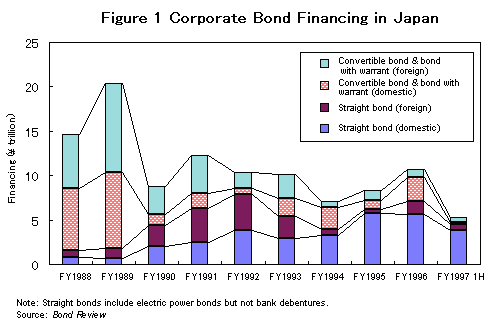
Moreover, banks have recently been reducing assets to boost their equity ratios. This has resulted in a very serious problem of credit tightening that is thwarting the economic recovery. In place of bank loans, companies have been increasingly relying on corporate bonds (particularly straight bonds). As Figure 1 shows, the value of straight bond issues is expected to reach a new high this fiscal year.
4. Credit Rating Data as Reflected in the Market
Figure 2 shows the credit spreads in the short-term credit market (the spreads between short-term Treasury Bonds (TB) on the one hand, and commercial paper (CP) and certificates of deposit (CD) on the other). When Hokkaido Takushoku Bank announced its closure on November 17 and Yamaichi Securities on November 24, they both stated that their failures were precipitated by large stock price declines and credit rating downgrades, making it difficult to obtain financing in the short-term credit market. In Figure 2, credit spreads rose sharply from the third week of November, temporarily reaching nearly four times normal levels. Since these credit spreads represent market averages, companies with relatively high credit risk (low credit rating) were subject to even higher spreads.
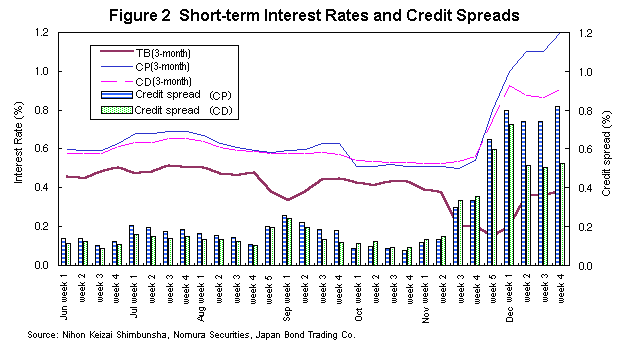
With a variety of issues supplied on the market, investors need to act in line with the principle of individual accountability. By using credit rating data, investors have come to strongly seek spreads corresponding to the credit risk.
(2) Straight Bond Market Trends
Next we look at the bond price valuation situation in the domestic straight bond market. Figure 3 shows the distribution of yield spreads between corporate bonds and government bonds with similar time to maturity. Government bond prices are obtained from the closing prices on the Tokyo Stock Exchange, while corporate bond prices are OTC standard quotations,4and the credit rating data comes from JBRI.
From Figure 3, we see that: (1) the longer the time to maturity, the smaller the spread, (2) the spread varies significantly among issues even if they have the same credit rating, and (3) corporate bonds with high credit ratings do not necessarily have smaller spreads. Although the statistical evidence is not great, on average, the lower the credit rating of a corporate bond, the greater the spread tends to be. We can also see an unexplained result in which a higher coupon rate is sometimes associated with a greater spread. Moreover, no clear analytical results were obtained regarding spread differences between secured and unsecured bonds. These characteristics, which became apparent several years ago, might be explained bluntly by saying that the corporate bond market had been insensitive to credit risk.
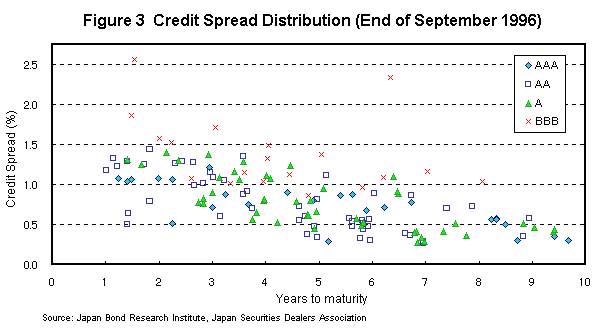
However, the reform of the bond quotation system (standard quotations for OTC transactions) in April 19975significantly increased the number of issues, and as the number of members reporting quotations increased, the above relationships changed greatly. For corporate and government bonds with the same time to maturity, the yield spread distribution as of December 1997 is shown in Figure 4.
Figure 4 shows that: (1) the effect of time to maturity has diminished, and (2) the spreads clearly reflect differences in credit ratings. These results are also confirmed by statistical analysis. However, the former dependence on coupon rates has declined. This term structure of credit spreads, a well known characteristic of the U.S. bond market, also conforms with bond price theory incorporating credit risk. While there may be disparities between the OTC quotations used in the analysis and actual transaction prices, we can optimistically state that Japan's bond market is also becoming suited for serious analysis based on investment theory.6
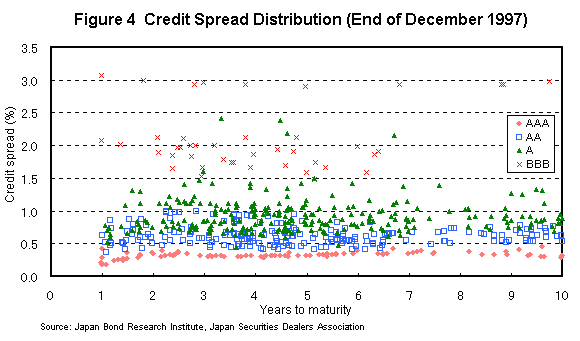
Presently, to have credit spreads clearly reflect credit ratings, a meaningful first step toward a theoretical analysis of the bond market is to estimate spot yield curves for different credit ratings.7Figure 5 shows spot yield curves estimated from OTC quotations for different credit ratings as of December 1997. We see that the government bond curve is lowest, and that yields rise as credit ratings decline. Since the yield for a BB rating shoots up to over 25 percent, the figure only includes a BBB rating. In fact, all the BB rated companies in the analysis are construction companies who were downgraded from BBB to speculative grade following last year's crisis among general contractors. These spot yield curves can be used to analyze whether specific corporate bond issues are priced at a premium or discount, and to calculate suspected default probabilities for valuation of credit derivatives and other financial products.
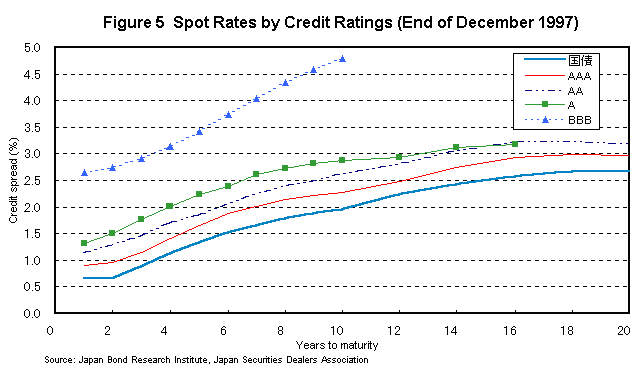
4 It is not clear to what extent OTC quotations reflect actual transaction prices. For the purpose of analysis, in this paper we assumed that OTC quotations are representative of the market.
5 For details, see "The Need for Further Bond Market Reforms," NLI Research, July 1997.
6 However, for long-term analysis, attention needs to be paid to the qualitative continuity of data. There is no problem if spread changes occur due to quantitative changes such as an increase in the number of issues. However, system reforms could cause price data to become qualitatively discontinuous.
7 The spot rate is the yield of zero-coupon bonds at a particular time to maturity. Since zero-coupon bonds do not generate cash flow until maturity, the spot rate is determined for each maturity. The spot yield curve plots the spot rates of zero-coupon bonds with various years to maturity.
5. Comparison of Credit Rating Agencies
Since credit ratings express the opinions of different agencies, disparities in ratings can be expected. Figure 6 is a split rating that is used to show such disparities. We studied the distribution of ratings for 265 companies (at the end of 1997) who have been rated by any of three Japanese credit rating agencies, and by either Moody's or Standard & Poor's of the U.S. The split rating of the highest rating from a Japanese agency and the lowest rating from a U.S. agency was large, averaging 3.2 notches and having a maximum of 8 notches.8
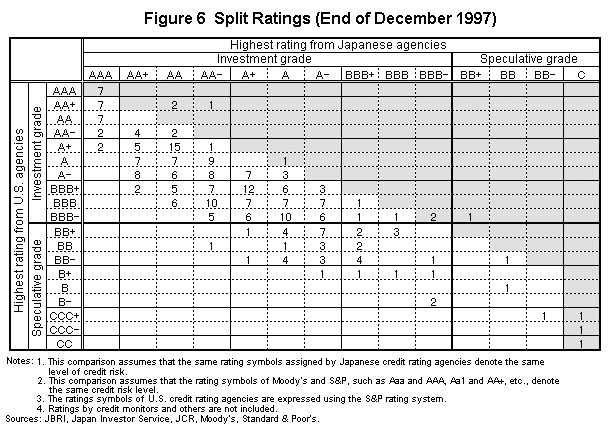
Ratings are determined through a comprehensive evaluation including quantitative factors (financial indicators such as operating profit ratio, equity ratio, etc.), qualitative factors (business foundation including industry trends, company characteristics, etc.), and factors specific to the bond (issue conditions, bond type, etc.). The split ratings emerge due to the different stances of agencies toward each of these factors.
Investment decisions can change considerably depending on which credit rating data is used. Usually, investors use the lowest rating in their analysis. However, this valuable source of information will be rendered useless unless applied with the appropriate investment stance and investment criteria.
8 A notch is a credit rating increment that is used to measure the difference between two credit ratings. For example, the following pairs differ by one notch: A+ and A, and A+ and AA-.
6. Conclusion
Companies should, in addition to aggressively pursuing disclosure, boldly challenge credit rating agencies when unsatisfactory ratings are issued. Ahead of the Big Bang, enhanced competition and analysis can work together to achieve a more efficient corporate bond market and improve the quality of credit rating data.
レポート紹介
-
研究領域
-
経済
-
金融・為替
-
資産運用・資産形成
-
年金
-
社会保障制度
-
保険
-
不動産
-
経営・ビジネス
-
暮らし
-
ジェロントロジー(高齢社会総合研究)
-
医療・介護・健康・ヘルスケア
-
政策提言
-
-
注目テーマ・キーワード
-
統計・指標・重要イベント
-
媒体
- アクセスランキング

















